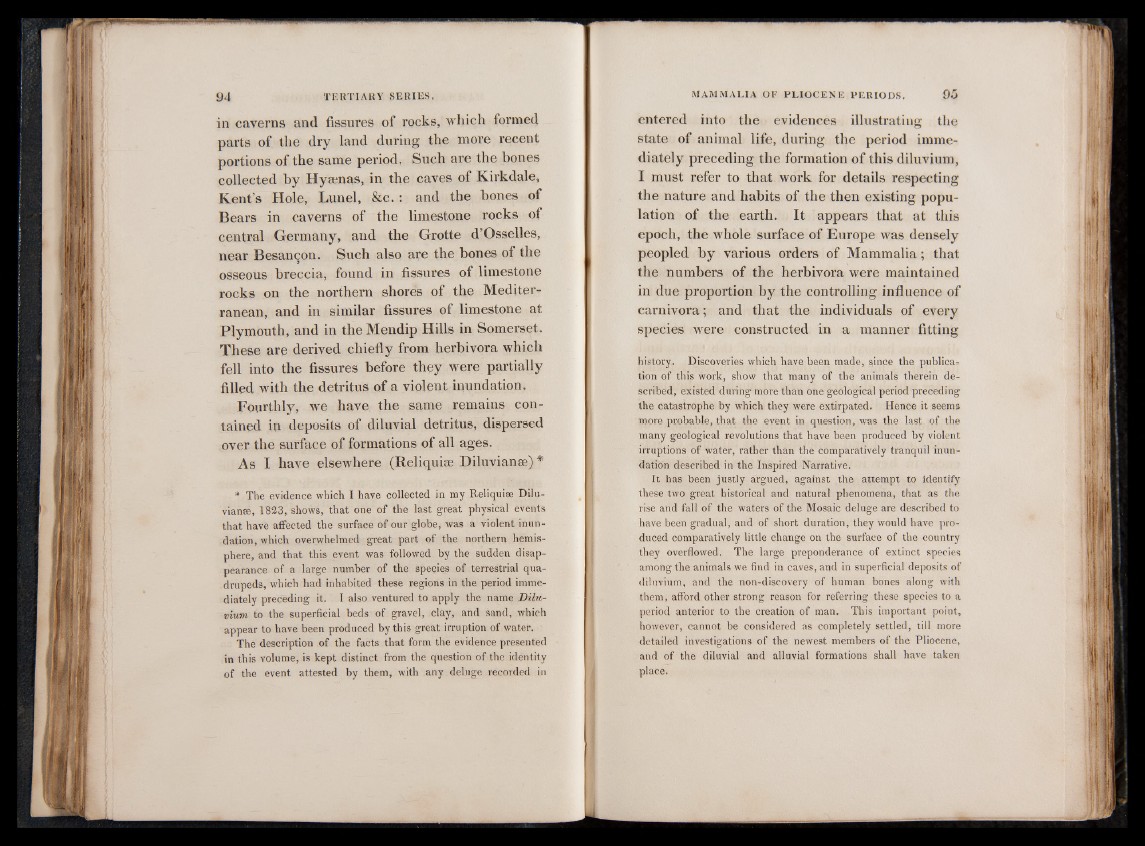
in caverns and fissures of rocks, which formed
parts of the dry land during the more recent
portions of the same period, Such are the bones
collected by Hyænas, in the caves of Kirkdale,
Kent’s Hole, Lunel, &c. : and the bones of
Bears in caverns of the limestone rocks of
central Germany, and the Grotte d’Osselles,
near Besançon. Such also are the bones of the
osseous breccia, found in fissures of limestone
rocks on the northern shores of the Mediter-^
ranean, and in similar fissures of limestone at
Plymouth, and in the Mendip Hills in Somerset.
These are derived chiefly from herbivora which
fell into the fissures before they were partially
filled with the detritus of a violent inundation.
Fourthly, we have the same remains contained
iu deposits of diluvial detritus, dispersed
over the surface of formations of all ages.
As I have elsewhere (Reliquiae Diluvianae) f *
* The evidence which I have collected in my Reliquiae Diluvianae,
1823, shows, that one of the last great physical events
that have affected the surface of our globe, was a violent inundation,
which overwhelmed great part of the northern hemisphere,
and that this event was followed by the sudden disappearance
of a large number of the species of terrestrial quadrupeds,
which had inhabited these regions in the period immediately
preceding it. I also ventured to apply the name Diluvium
to the superficial beds of gravel, clay, and sand, which
appear to have been produced by this great irruption of water.
The description of the facts that form the evidence presented
in this volume, is kept distinct from the question of the identity
of the event attested by them, with any deluge recorded in
entered into the evidences illustrating the
state of animal life, during the period immediately
preceding the formation of this diluvium,
I must refer to that work for details respecting
the nature and habits of the then existing population
of the earth. It appears that at this
epoch, the whole surface of Europe was densely
peopled by various orders of Mammalia; that
the numbers of the herbivora were maintained
in due proportion by the controlling influence of
carnivora; and that the individuals of every
species were constructed in a manner fitting
history. Discoveries which have been, made, since the publication
of this work, show that many of the animals therein described,
existed during more than one geological period preceding
the catastrophe by which they were extirpated. Hence it seems
more probable, that the event in question, was the last of the
many geological revolutions that have been produced by violent
irruptions of water, rather than the comparatively tranquil inundation
described in the Inspired Narrative.
It has been justly argued, against the attempt to identify
these two great historical and natural phenomena, that as the
rise and fall of the waters of the Mosaic deluge are described to
have been gradual, and of short duration, they Would have produced
comparatively little change on the surface of the country
they overflowed. The large preponderance of extinct species
among the animals we find in caves, and in superficial deposits of
diluvium, and the non-discovery of human bones along with
them, afford other strong reason for referring these species to a
period anterior to the creation of man. This important point,
however, cannot be considered as completely settled, till more
detailed investigations of the newest members of the Pliocene,
and of the diluvial and alluvial formations shall have taken
place.